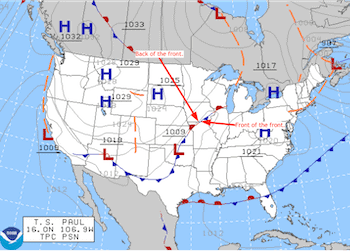
As a result of watching our local meteorologists forecast the weather, I have an idea that will simplify the way those meteorologists present the forecasts. That idea will also help their viewers understand their forecasts and be able to explain them to family, friends, and other loved ones who might not have TVs or might have better things to do than to watch local meteorologists forecast the weather.
Since we (at least in the West) read from left to right — and since most weather fronts (at least in the Northern Hemisphere) move west to east (which is the same as left to right, depending on your orientation) — here’s all we have to do, in two simple steps (please refer to the figure below):

See how easy that is?
The Vernacular
Along with being able to identify whether you’re on the back or the front of the front, there are two other things to be aware of when you’re listening to local weather forecasts, at least in Connecticut:

The most reliable way to be sure of anything relating to the weather as forecast by local meteorologists (at least in Connecticut) is AccuWindow Weather. If you’ve already moved down into your survival bunker ahead of the 2024 Presidential election and have no windows down there — and presuming you have a cell signal in your bunker — call 1-800-WTF-RAIN. You’ll get someone at the National Weather Service who’ll tell you in very plain language what the hell’s going on weather-wise where you are.
In the meantime, whether you’re on the back of the front or the front of the front, take the proper precautions for the upcoming timeframe.
And shut off the TV.
Originally Published on https://www.bizcatalyst360.com/category/lifecolumns/notes-to-self/
Notifications